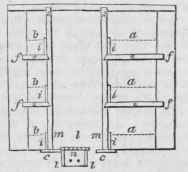Mushroom. Part 3
Description
This section is from the book "A Dictionary Of Modern Gardening", by George William Johnson, David Landreth. Also available from Amazon: The Winter Harvest Handbook: Year Round Vegetable Production Using Deep Organic Techniques and Unheated Greenhouses.
Mushroom. Part 3
Heating By Hot-Water
Instead of flues, as used by Mr. Oldacker, the following plan, by Mr. Sellers, gardener to L. V. Watkins, Esq., of Pennoyre, may be substituted: -
Fig. 103.

"This cut represents a section of the interior of the house, with three beds for mushrooms, a a a, eighteen feet long, and three feet wide, and three shelves for forcing rhubarb, 6 6 6. If circumstances permit, these shelves may be made wider, and used for mushrooms. Stones are placed on each side of the passage, at c c, for the standards to be placed on which support the bearers of the shelves, and mortised at d d. The stones should be about six inches square on the surface, and three inches thick; and the standards about three inches and a half square.
"When the standards and cross-bnarers are fixed, the shelves may be formed by laying along the latter boards one inch and a half thick; and it will be convenient, when removing or putting fresh dung, if a board eight inches broad and one inch thick is placed behind the standard at i, or cut so as to come flush with it.
"When the shelves are fixed, a trench, nine inches deep, is made in the passage, m I m, for the reception of the pipes; on each side this trench a brick-wall, i i, is built, to prevent rubbish from falling in. The bottom of the trench must be puddled with clay, so that the water thrown on the pipes will not escape.
"The pipes used are about one inch and a half bore, and they are laid in the trench three inches apart; a wooden trellis is placed over them, resting on the brick walls i i, and forms a path.
"When the mushrooms want steaming, it is only necessary to take a fine rose watering-pot, and sprinkle the pipes with it till the steam arises so thick that objects cannot be seen at the further end of the house. Steaming is better than watering over head for mushrooms, as much water is injurious to the spawn. - Gard. Chron.
Spawn, Where To Be Found
Spawn is constituted of masses of white fibres arising from the seeds of mushrooms that have fallen into situations suitable for their germination, from which it is to be obtained: such places are stable dung-hills, dungy horse-rides in stable-yards, horse mill-tracks, dry spongy composts: the droppings of hard-fed horses also produce it in greater abundance than the dung of any other animal; and more sparingly under sheds, where horses, oxen, or sheep have been kept. The dung of the two latter affords it in greater perfection than that of grass-fed horses. It has also been found in pigeons'dung; but the most certain mode of obtaining it is to open the ground about mushrooms growing in pastures, though it is said not to be so productive.
Time Of Collecting
It must be collected in July, August, and September, being reckoned in the greatest perfection in this last month. It may be found, however, and should be collected, when it appears in the spring. It generally occurs spread through the texture of cakes, or lumps of dry rotted dung. Put it in a heap under a dry shed; and a current of air, passing through the shed, is of great utility. If kept dry, spawn may be preserved three or four years: if damp, it will either vegetate before being planted, or putrefy.
Spawn must not be so far advanced in vegetation as to appear in threads or fibres; for, when in this state, it is no longer applicable to a mushroom-bed; it may produce a mushroom if left to itself, but otherwise is useless. Spawn proper for inserting in a bed should have the appearance of indistinct white mould.
Continue to:


